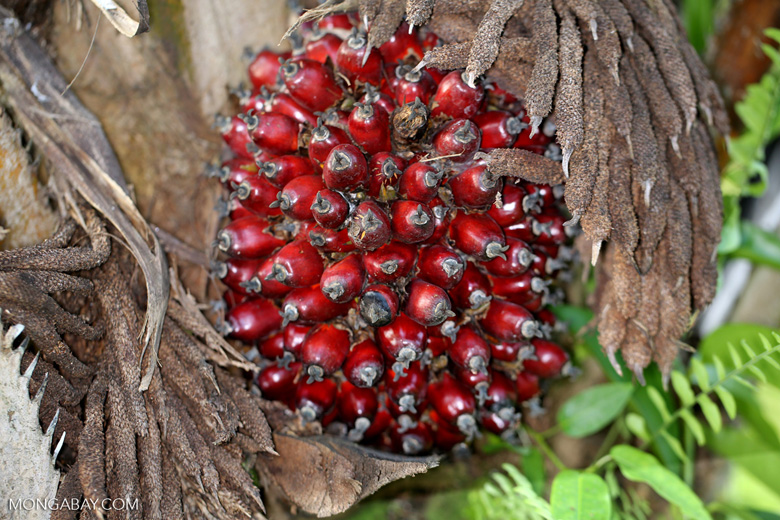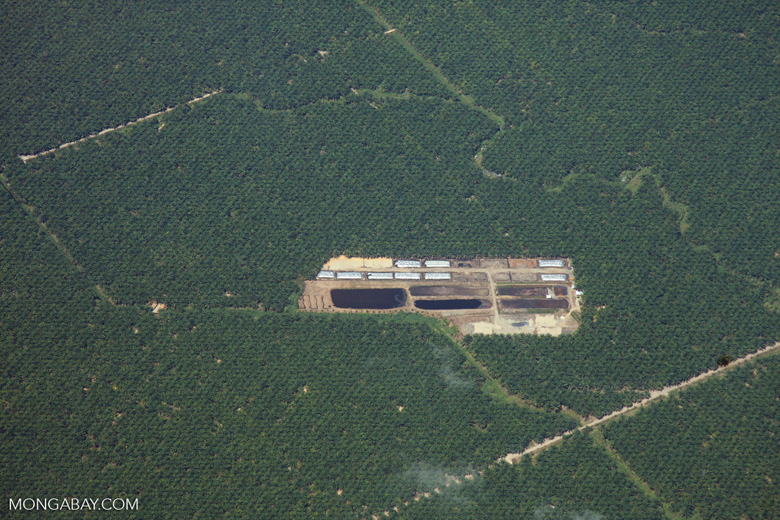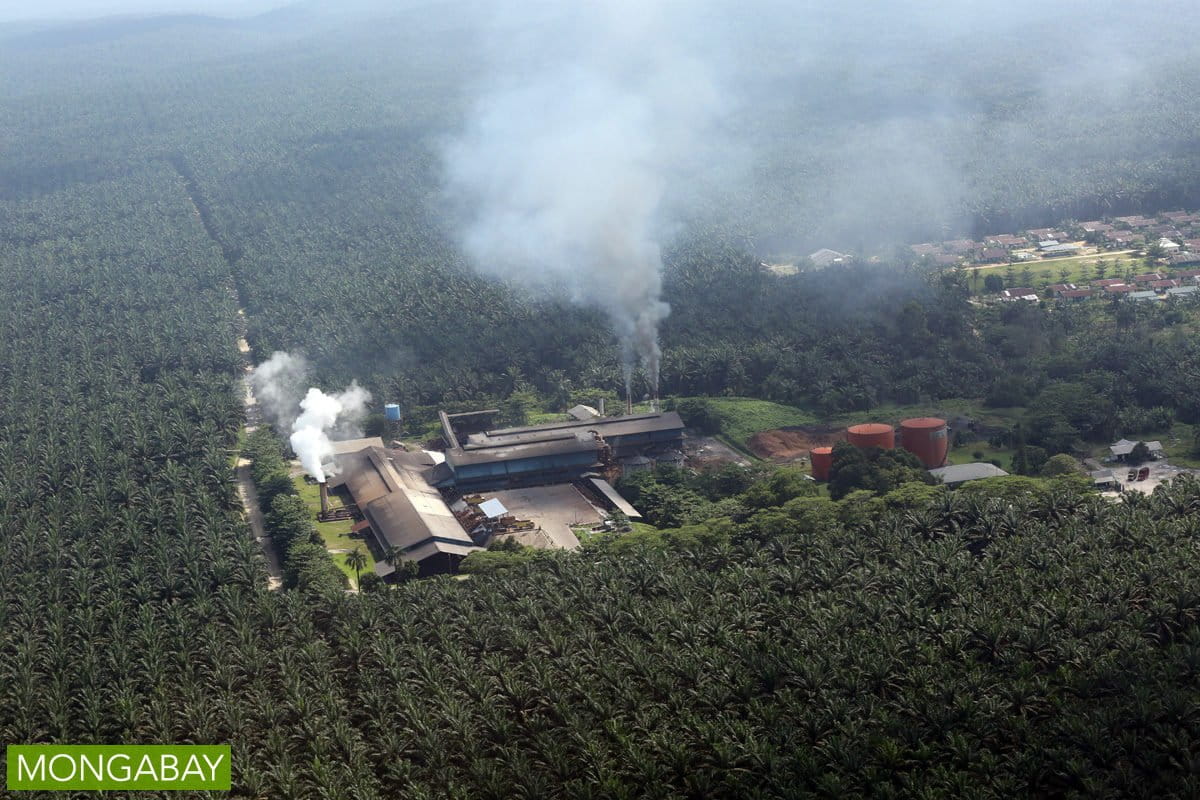- In this commentary, Earthworm Foundation’s Rob McWilliam argues that palm oil mills are playing a large role in driving the palm oil industry’s destruction of the world’s rainforests, and that this role is often ignored.
- McWilliam writes that new research shows how to end the damage palm oil mills are causing.
- This article is a commentary and the views expressed are those of the author, not necessarily Mongabay.
For decades, Indonesia has been blighted by some of the highest levels of deforestation on earth. It also provides more than half the world’s palm oil. The two things are directly related.
Palm oil – with its high yields and low cost – touches our lives in ways few of us grasp: it’s in everything from cooking oil to pizza dough, biodiesel to shampoo, infant formula to chocolate. But meeting the demand for the planet’s most widely consumed vegetable oil, comes at a terrible cost.
Indonesia’s rainforests – the third largest in the world after the Amazon and the Congo Basin – have been razed, burned and logged to make way for oil palm plantations. Between 2001 and 2018, 16% of the country’s tree cover disappeared, and it’s estimated that between 2008 and 2010, palm oil plantations were responsible for almost 60% of deforestation.
This impacts the climate (around half of Indonesia’s greenhouse gas emissions come from deforestation and other land use changes). It destroys wildlife (almost 150,000 critically endangered orangutans across Borneo were lost between 1999 and 2015). And it affects people (indigenous people have been displaced and deprived of their land rights).

So what can be done?
While successful initiatives to reduce the deforestation which taints palm oil’s supply chains exist, such as private sector No Deforestation, No Peatland, No Exploitation (NDPE) policies, and Indonesia has cut its deforestation rates in recent years, the issue is far from being resolved. The fires that swept through Indonesia’s forests in 2019 are a graphic illustration: 80% of them, according to officials, were started to clear land for oil palm plantations.
Hungry mills
There is, however, one critical factor that helps drive the deforestation caused by the expansion of palm oil plantations, and which deserves far greater attention.
This is the decisive role played by the mills where the harvested fruit from the oil palm plant is processed, and the crude palm oil extracted. According to 2018 research, after Indonesia’s central government, these palm oil mills have the greatest power to influence behavior in the supply chain, especially on those actors who are managing and developing plantation areas.

In simple terms, this is because the mills seek to run at or as close as possible to their built capacity to achieve a rapid return on the investment in building and maintaining them. In cases where a palm oil mill runs at less than maximum capacity, they will directly or indirectly incentivize further plantation development, which more often than not comes at the expense of forests.
These “hungry mills” therefore can act like vacuum cleaners, sucking up land and forests to make way for oil palm plantations.
For companies trying to eradicate deforestation from their supply chains, this poses a serious challenge. How, for instance, can Nestlé – which has around 1,400 mills in its palm oil supply chains – identify which of them are “hungry mills,” and potential engines of deforestation, without going on the ground to check each one?
Combining new data to drive action
A new study conducted by Cristina Joss from the Institute of Geography and co-led by Dr. Cornelia Hett from the University of Bern’s Centre for Development and Environment, and Earthworm Foundation, sets out to answer this question, and provides insights which offer a potential path to help end the deforestation that continues to blemish palm oil supply chains.
The study used two key data inputs.
The first was historical and recent land cover information, including the presence and age of oil palm plantation areas, analyzed from satellite images produced by the Starling monitoring service. The second was palm oil mill capacity data provided by researchers at the Conservation Economics Lab at the University of California, Santa Barbara.

In combining these two datasets it was possible to model the productivity of different-aged plantation areas, and determine mills that weren’t able to access enough fruit within a travel distance of 24 hours to meet their built processing capacity, thereby identifying hungry mills in Central Kalimantan, where the future risk of forest loss due to oil palm is estimated to be very high.
The results vividly illustrate the scale of the challenge we face in breaking the link between deforestation and palm oil expansion.
The study found a significant shortfall in the ability of the existing plantation areas in Central Kalimantan to meet the capacity of the areas’ mills: with the plantations producing just two-thirds of the oil palm volume the mills are capable of processing.
Moreover, 20% of the mills analyzed were found to be operating well below their built capacity, considering a 24-hour travel distance to obtain oil palm fruit. The study also worked to identify if this unmet demand for fruit could be met with plantation development on land that isn’t forested, which appears to be theoretically possible.
Using these or similar methods, therefore, could theoretically have a profound impact in the long battle to remove the stain of environmental destruction from palm oil’s supply chains.
The question is how? How can companies and governments use data identifying “hungry mills” to help end the deforestation associated with palm oil?
A number of potential avenues come to mind.
For a start, having such data can help inform governments in their planning and licensing decisions, so that new mills are only built where their needs can be met without encroaching into forests.

Similarly, the allocation of new licenses for palm oil plantation development could be directed to where existing mills need more fruit. The results of the study could also feed government programs to support growers and smallholders with improving production.
It can also give palm oil buyers the means to identify the “hungry mills” in their supply chains, and so focus their limited engagement capacity on ensuring that these mills can access adequate fruit without compromising NDPE policies. The results can also guide financial institutions to invest in operations that can meet their built processing capacity without converting forests.
In these ways, instead of being vacuums hoovering up Indonesia’s rainforests, the mills can be turned into critical links in sustainable palm oil supply chains.
Rob McWilliam is the Director of Technical Services at Earthworm Foundation, a non-profit organization working with partners from farms to boardrooms to build value chains that work for people and nature. He was also instrumental in developing the Starling service in partnership with Airbus.
Banner image of a palm oil mill in Indonesia by Rhett Butler/Mongabay.
Feedback: Use this form to send a message to the editor of this post. If you want to post a public comment, you can do that at the bottom of the page.
